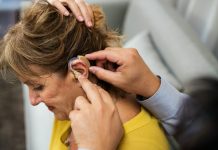
While an impending storm will trigger cautionary news reports about the risk of a heart attack while shoveling snow, you’re less likely to hear how twisting and turning while moving heavy amounts of the tiny ice crystals may increase your risk of developing a hernia.
Hernias are a common medical condition that can develop for many reasons.
“While we typically associate heavy lifting or strenuous activity with the development of a hernia, other congenital abdominal wall defects can lead to hernia formation with less strenuous activity,” said Dr. Michael Abboud, chief of the Division of General Surgery and chair of the Department of Surgery at Penn State Health St. Joseph Medical Center.
“Hernias may develop in a number of different locations, and can be present at birth or develop later in life, for a number of reasons.”
What is a hernia?
The classic description of a hernia includes the bulging of an organ or tissue beyond where it is normally confined.
Hernias most often occur when there is an area of weakness in a muscular structure, such as the abdominal wall muscles.
This allows contents of the abdomen to push through the wall and form a pouch called a hernia sac.
People can develop a variety of types of hernias, including inguinal (groin), umbilical, ventral or incisional.
How do you develop a hernia?
Most acquired hernias form when there is a loss of mechanical integrity of the abdominal wall muscles and tendons required to contain viscera and support the torso.
Genetic or systemic disorders may predispose patients to primary hernia formation, while defective wound healing following surgery and hernia repairs may lead to incisional hernias.
The abdominopelvic cavity is a cylinder enveloped by muscles, tendons and bony structures. Any pressure generated inside the cavity is transmitted equally to the walls.
In response to increased abdominal pressure, the muscular abdominal wall contracts to generate counterpressure.
A hernia happens when the wall ruptures at its weakest point. And once a hernia has formed, it may continue to grow.
Other conditions and risk factors unique to individual hernias include chronic coughing, smoking, heavy lifting, straining, obesity and pregnancy.
What are the symptoms of a hernia?
The clinical presentation of abdominal wall hernias can vary depending upon their location and size. Small hernias can be asymptomatic or have varying degrees of symptoms, including pain or discomfort as the hernia contents protrude through the defect.
Most often, patients will complain of a bulge somewhere in the abdominal wall. Coughing or straining may produce or aggravate pain or discomfort.
Larger hernias can push against the overlying skin, leading to areas of erythema, ischemia or ulceration.
Although any abdominal wall hernia can present with complications due to incarceration of intestinal contents in the defect, many varieties of hernias frequently go unrecognized if they are asymptomatic until they may present as bowel obstruction due to incarceration.
What happens if a hernia isn’t treated?
Hernias may remain asymptomatic or can progress over time from being reduceable to incarcerated ― where tissue becomes trapped in the hernia sac ― or even strangulated ― where blood flow is cut off.
Patients are encouraged to seek medical advice to determine the nature and severity of a hernia and to discuss appropriate options ranging from close observation of small, asymptomatic hernias, to surgical repair and correction of the defect.
What is the treatment for a hernia?
Hernia repair can be done using either open surgery or minimally invasive techniques, such as laparoscopic and robotic-assisted surgeries.
With an open surgery, the surgeon creates an incision to repair the hernia using sutures either alone or in combination with mesh.
Minimally invasive hernia surgery is an alternate option in which the surgeon can repair or close the hernia defect, most commonly with the use of mesh.
Each approach is tailored to the patient and the clinical condition and is determined by the surgeon in conjunction with the patient.
The various approaches to the repair may require using different types of anesthesia ranging from sedation and local to general anesthesia.
Robotic or laparoscopic approaches have some perceived advantages, including a potential expedited healing process and less pain compared with open surgery, but limitations and restrictions following surgery are very often the same.
“In every case, we tailor treatment recommendations to each patient’s scenario,” Abboud said.
“It is important to ensure patients are educated about their diagnosis and treatment options so they feel comfortable with their physician and treatment plan.”
If you care about heart health, please read studies about how drinking milk affects risks of heart disease, and herbal supplements could harm your heart rhythm.
For more information about heart health, please see recent studies that avocados can support a heart-healthy diet, and results showing after COVID-19, watch for these potential heart and brain problems.



